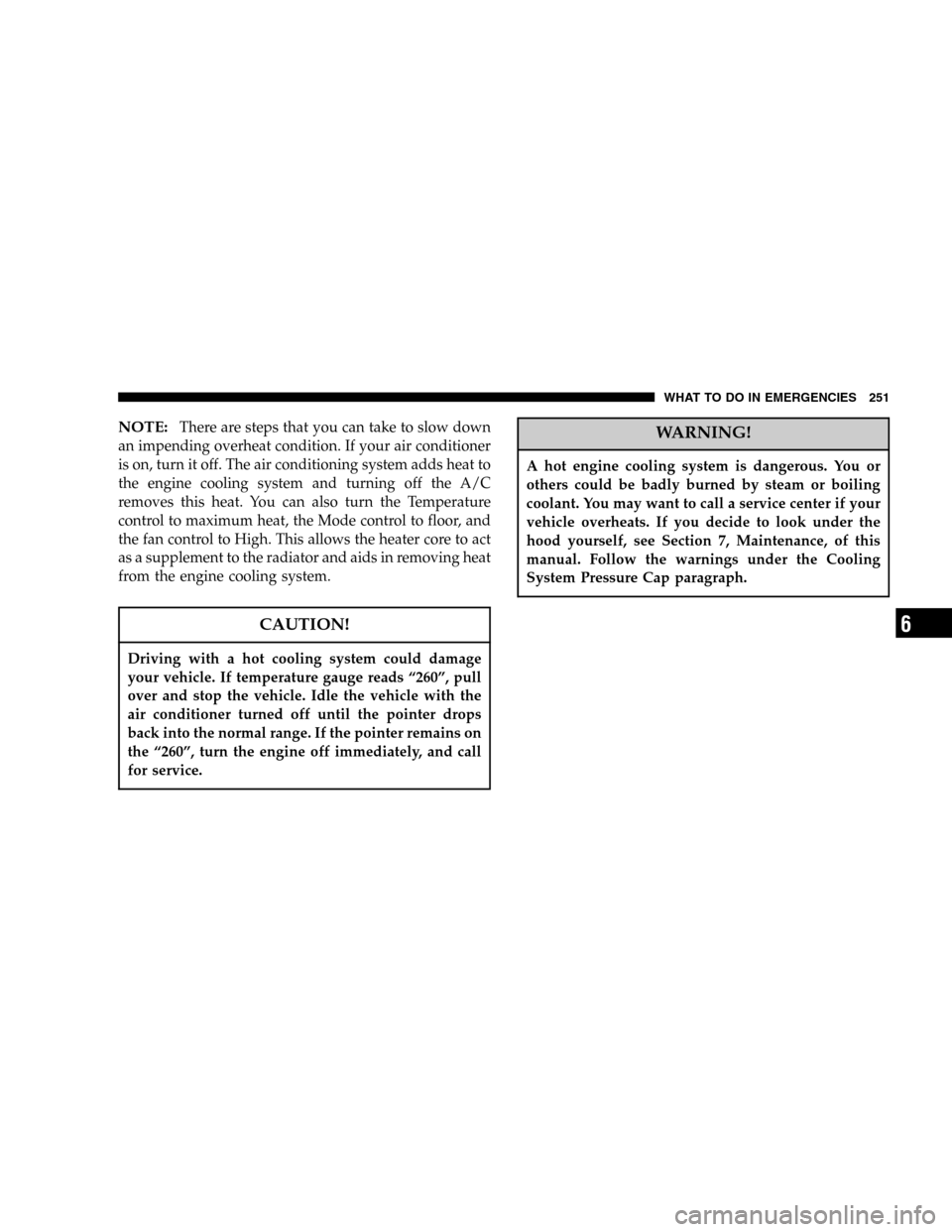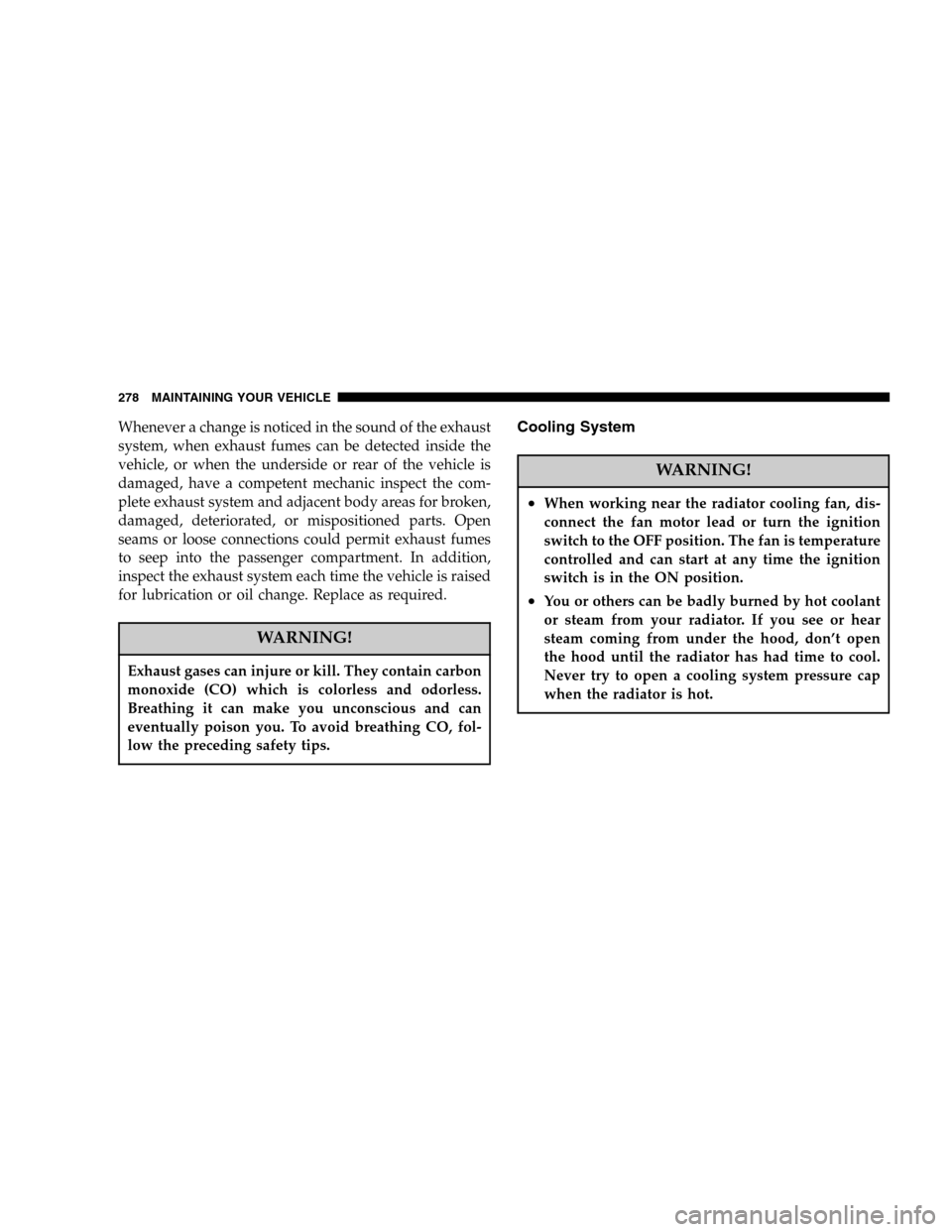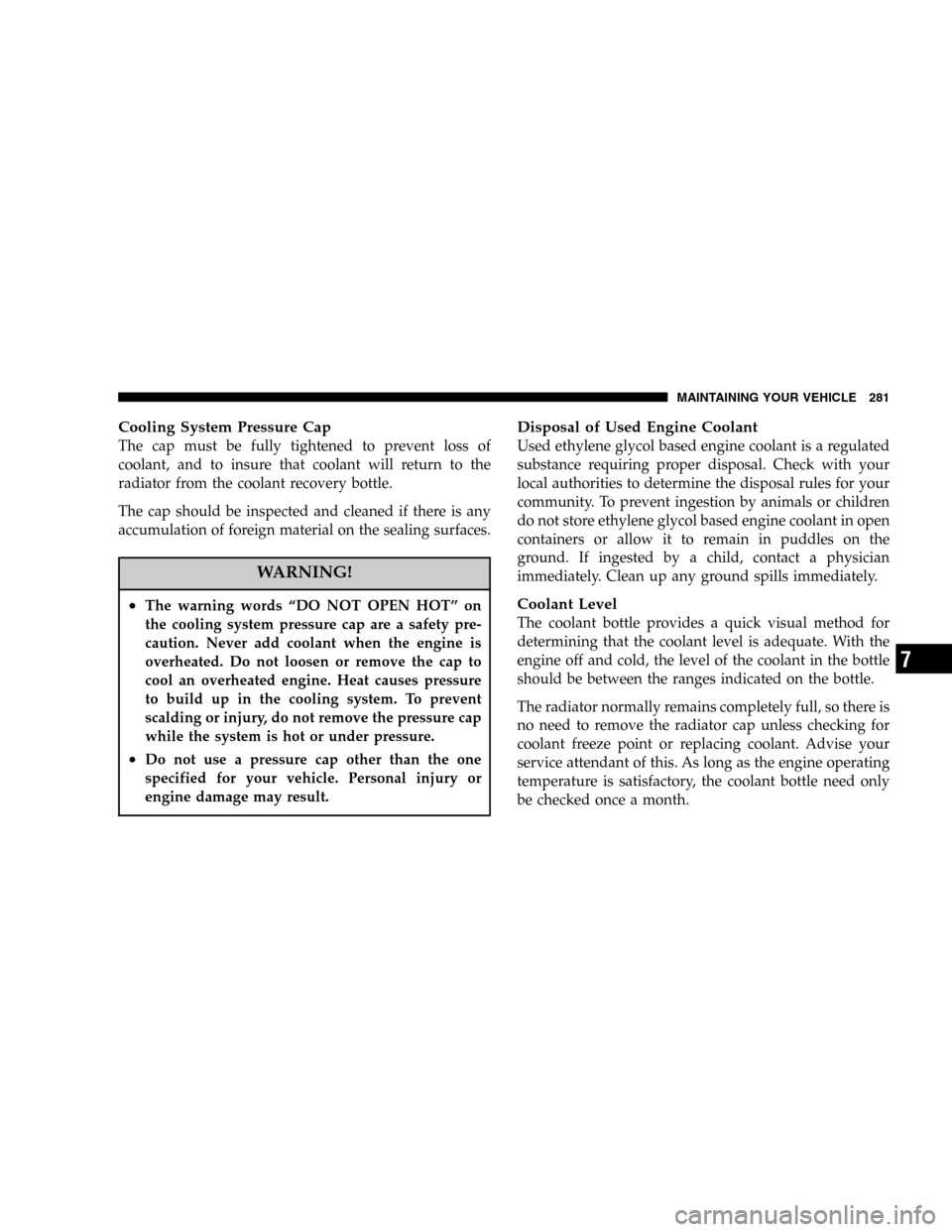radiator cap DODGE MAGNUM SRT 2006 1.G Owners Manual
[x] Cancel search | Manufacturer: DODGE, Model Year: 2006, Model line: MAGNUM SRT, Model: DODGE MAGNUM SRT 2006 1.GPages: 344, PDF Size: 10.88 MB
Page 251 of 344

NOTE:There are steps that you can take to slow down
an impending overheat condition. If your air conditioner
is on, turn it off. The air conditioning system adds heat to
the engine cooling system and turning off the A/C
removes this heat. You can also turn the Temperature
control to maximum heat, the Mode control to floor, and
the fan control to High. This allows the heater core to act
as a supplement to the radiator and aids in removing heat
from the engine cooling system.
CAUTION!
Driving with a hot cooling system could damage
your vehicle. If temperature gauge reads “260”, pull
over and stop the vehicle. Idle the vehicle with the
air conditioner turned off until the pointer drops
back into the normal range. If the pointer remains on
the “260”, turn the engine off immediately, and call
for service.
WARNING!
A hot engine cooling system is dangerous. You or
others could be badly burned by steam or boiling
coolant. You may want to call a service center if your
vehicle overheats. If you decide to look under the
hood yourself, see Section 7, Maintenance, of this
manual. Follow the warnings under the Cooling
System Pressure Cap paragraph.
WHAT TO DO IN EMERGENCIES 251
6
Page 278 of 344

Whenever a change is noticed in the sound of the exhaust
system, when exhaust fumes can be detected inside the
vehicle, or when the underside or rear of the vehicle is
damaged, have a competent mechanic inspect the com-
plete exhaust system and adjacent body areas for broken,
damaged, deteriorated, or mispositioned parts. Open
seams or loose connections could permit exhaust fumes
to seep into the passenger compartment. In addition,
inspect the exhaust system each time the vehicle is raised
for lubrication or oil change. Replace as required.
WARNING!
Exhaust gases can injure or kill. They contain carbon
monoxide (CO) which is colorless and odorless.
Breathing it can make you unconscious and can
eventually poison you. To avoid breathing CO, fol-
low the preceding safety tips.
Cooling System
WARNING!
•When working near the radiator cooling fan, dis-
connect the fan motor lead or turn the ignition
switch to the OFF position. The fan is temperature
controlled and can start at any time the ignition
switch is in the ON position.
•You or others can be badly burned by hot coolant
or steam from your radiator. If you see or hear
steam coming from under the hood, don’t open
the hood until the radiator has had time to cool.
Never try to open a cooling system pressure cap
when the radiator is hot.
278 MAINTAINING YOUR VEHICLE
Page 279 of 344

Coolant Checks
Check engine coolant (antifreeze) protection every 12
months (before the onset of freezing weather, where
applicable). If coolant is dirty or rusty in appearance, the
system should be drained, flushed and refilled with fresh
coolant. Check the front of the A/C condenser for any
accumulation of bugs, leaves, etc. If dirty, clean by gently
spraying water from a garden hose vertically down the
face of the condenser.
Check the coolant recovery bottle tubing for brittle rub-
ber, cracking, tears, cuts and tightness of the connection
at the bottle and radiator. Inspect the entire system for
leaks.
With the engine at normal operating temperature (but
not running), check the cooling system pressure cap for
proper vacuum sealing by draining a small amount of
coolant from the radiator drain cock. If the cap is sealing
properly, the engine coolant (antifreeze) will begin to
drain from the coolant recovery bottle. DO NOT RE-
MOVE THE COOLANT PRESSURE CAP WHEN THE
COOLING SYSTEM IS HOT.
Cooling System — Drain, Flush and Refill
At the intervals shown on the Maintenance Schedules,
the system should be drained, flushed and refilled.
If the solution is dirty or contains a considerable amount
of sediment, clean and flush with a reliable cooling
system cleaner. Follow with a thorough rinsing to remove
all deposits and chemicals. Properly dispose of old
antifreeze solution.
Selection Of Coolant
Use only the manufacturer’s recommended coolant, refer
to Fluids, Lubricants and Genuine Parts for correct
coolant type.
MAINTAINING YOUR VEHICLE 279
7
Page 281 of 344

Cooling System Pressure Cap
The cap must be fully tightened to prevent loss of
coolant, and to insure that coolant will return to the
radiator from the coolant recovery bottle.
The cap should be inspected and cleaned if there is any
accumulation of foreign material on the sealing surfaces.
WARNING!
•The warning words “DO NOT OPEN HOT” on
the cooling system pressure cap are a safety pre-
caution. Never add coolant when the engine is
overheated. Do not loosen or remove the cap to
cool an overheated engine. Heat causes pressure
to build up in the cooling system. To prevent
scalding or injury, do not remove the pressure cap
while the system is hot or under pressure.
•Do not use a pressure cap other than the one
specified for your vehicle. Personal injury or
engine damage may result.
Disposal of Used Engine Coolant
Used ethylene glycol based engine coolant is a regulated
substance requiring proper disposal. Check with your
local authorities to determine the disposal rules for your
community. To prevent ingestion by animals or children
do not store ethylene glycol based engine coolant in open
containers or allow it to remain in puddles on the
ground. If ingested by a child, contact a physician
immediately. Clean up any ground spills immediately.
Coolant Level
The coolant bottle provides a quick visual method for
determining that the coolant level is adequate. With the
engine off and cold, the level of the coolant in the bottle
should be between the ranges indicated on the bottle.
The radiator normally remains completely full, so there is
no need to remove the radiator cap unless checking for
coolant freeze point or replacing coolant. Advise your
service attendant of this. As long as the engine operating
temperature is satisfactory, the coolant bottle need only
be checked once a month.
MAINTAINING YOUR VEHICLE 281
7
Page 331 of 344

Location.........................256,273
Bearings.............................. 287
Belts, Drive........................... 270
Body Mechanism Lubrication.............. 276
B-Pillar Location........................ 211
Brake Assist System..................... 100
Brake Control System, Electronic............ 99
Brake, Parking......................... 201
Brake System.......................202,283
Anti-Lock.........................99,202
Fluid Check......................284,303
Hoses.............................. 283
Warning Light....................... 137
Brake/Transmission Interlock.............. 199
Break-In Recommendations, New Vehicle...... 56
Bulb Replacement...................... 297
Bulbs, Light........................... 296
Calibration, Compass.................... 144
Capacities, Fluid....................... 302
Caps, Filler
Fuel............................... 233
Radiator (Coolant Pressure).............. 281Car Washes........................... 287
Carbon Monoxide Warning.............57,232
Cargo Compartment
Luggage Carrier...................... 127
Cargo Management System............... 121
Cargo Organizer...................... 125
Rollaway Tonneau Cover............... 123
Tri-Fold Load Floor.................... 121
Waterproof Liner..................... 124
Cargo Tie-Downs....................... 125
Cassette Tape and Player Maintenance....... 175
Catalytic Converter..................... 271
CD Player.........................150,157
Cellular Phone.......................... 66
Chains, Tire........................... 226
Chart, Tire Sizing....................... 208
Child Restraint...................49,51,53,54
Child Restraint Tether Anchors............. 53
Child Safety Locks....................... 18
Clean Air Gasoline...................... 230
Climate Control........................ 176
Clock................................ 158
Compact Disc Maintenance............... 175
INDEX 331
10
Page 332 of 344

Compass............................. 144
Compass Calibration.................... 144
Compass Variance...................... 144
Computer, Trip/Travel................... 143
Console.............................. 120
Console, Floor......................... 120
Console, Overhead...................... 107
Contract, Service....................... 324
Coolant Pressure Cap.................... 281
Cooling System........................ 278
Adding Coolant (Antifreeze)............. 280
Coolant Capacity..................... 302
Coolant Level.....................279,281
Disposal of Used Coolant............... 281
Drain, Flush, and Refill................. 279
Inspection........................... 281
Points to Remember................... 282
Pressure Cap........................ 281
Radiator Cap........................ 281
Selection of Coolant (Antifreeze)....279,302,303
Cruise Control (Speed Control)............. 104
Cup Holder........................ 119,290
Customer Assistance.................... 322Data Recorder, Event..................... 48
Dealer Service......................... 266
Defroster, Rear Window.................. 177
Defroster, Windshield...............58,178,183
Delay (Intermittent) Wipers................ 96
Diagnostic System, Onboard............... 264
Dimmer Switch, Headlight................. 96
Disposal
Antifreeze (Engine Coolant)............. 281
Door Locks............................ 15
Door Locks, Automatic................... 17
Door Opener, Garage.................... 108
Drive Belts............................ 270
Driving
On Slippery Surfaces.................. 257
Electric Remote Mirrors................... 65
Electrical Power Outlets.................. 116
Electronic Brake Control System............. 99
Electronic Speed Control................. 104
Electronic Stability Program............... 100
Electronic Vehicle Information Center........ 140
332 INDEX
Page 338 of 344

Pets.................................. 56
Phone, Cellular......................... 66
Phone, Hands-Free....................... 66
Placard, Tire and Loading Information....... 211
Power
Brakes............................. 202
Distribution Center.................... 290
Door Locks.......................... 16
Mirrors............................. 65
Outlet.............................. 116
Seats............................... 85
Steering............................ 205
Steering, Checking.................... 276
Sunroof............................ 113
Windows............................ 23
Pregnant Women and Seat Belts............. 34
Programmable Electronic Features.....108,112,148
Programming Transmitters.............108,112
Radial Ply Tires........................ 218
Radiator Cap (Coolant Pressure Cap)........ 281
Radio Broadcast Signals.................. 174
Radio Operation..................150,157,176Radio Remote Controls.................. 172
Radio, Satellite......................... 168
Radio (Sound Systems)................150,157
Rear Liftgate........................... 26
Rear Seat, Folding....................... 89
Rear Window Defroster.................. 177
Rearview Mirrors........................ 63
Reclining Front Seats..................... 86
Recorder, Event Data..................... 48
Recreational Towing..................... 247
Refrigerant............................ 275
Reminder, Seat Belt...................... 33
Remote Keyless Entry.................... 19
Remote Sound System Controls............ 172
Replacement Tires...................... 220
Reporting Safety Defects................. 325
Restraint, Head......................... 88
Restraints, Occupant..................... 27
Rocking Vehicle When Stuck.............. 258
Roof Rack............................ 127
Rotation, Tires......................... 227
Safety Checks Inside Vehicle............... 57
338 INDEX